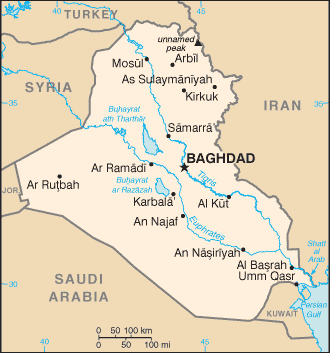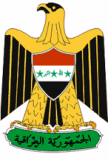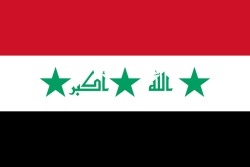Republic of Iraq
Related Categories:


|
Hundreds of Iraqi flags bearing the phrase 'Allah Akbar' have appeared throughout the streets of the northern Iraqi city of Mosul in what analysts are calling an act of Arab defiance.
english.aljazeera.net/
The design consists of a pale blue crescent on a white background, with a yellow strip between two blue lines at the bottom.
news.bbc.co.uk/
Description and Symbolism of the Iraqi Flag.
www.fotw.us/
Iraq has a rich history dating back to ancient Mesopotamia. Historians identify the region between the Tigris River and the Euphrates River as the Fertile Crescent, a cradle of civilization, and as the birthplace of writing.
en.wikipedia.org/
People
Almost 75% of Iraq's population live in the flat, alluvial plain stretching southeast from Baghdad and Basrah to the Persian Gulf. The Tigris and Euphrates Rivers carry about 70 million cubic meters of silt annually to the delta. Known in ancient times as Mesopotamia, the region is the legendary locale of the Garden of Eden. The ruins of Ur, Babylon, and other ancient cities are in Iraq.
Iraq's two largest ethnic groups are Arabs and Kurds. Other distinct groups are Turcoman, Chaldeans, Assyrians, Persians, and Armenians. Arabic is the most commonly spoken language. Kurdish is spoken in the north, and English is the most commonly spoken Western language.
The majority (60-65%) of Iraqi Muslims are members of the Shi'a sect, but there is a large (32-37%) Sunni population as well, made up of both Arabs and Kurds. Small communities of Christians, Jews, Bahais, Mandaeans, and Yezidis also exist. Most Kurds are Sunni Muslim but differ from their Arab neighbors in language, dress, and customs.
Political Conditions
Since March 2006, the Government of Iraq has been a broad coalition led by a Shi’ite legislative bloc known as the United Iraqi Alliance (UIA). The UIA currently holds 128 of 275 seats in the Council of Representatives. The UIA is currently composed of SCIRI, the al-Sadr movement, al-Da’wa, Jama’at al-Fadilah, and various independents. Politicians with Sunni religious affiliations, including the Tawafooq and Hewar groups, presently hold 59 seats in the Council of Representatives. The Kurdish bloc known as the Democratic Patriotic Alliance of Kurdistan (which includes the KDP & PUK) holds 53 legislative seats. Ayad Allawi’s Iraqi National Accord (INA) holds 25 seats. The remaining seats are composed of various independent and secular politicians.
With regard to the executive branch, much care has been given to ensure that there is proportionate distribution of ministerial positions among the three major ethnic groups. For example, in the Presidency Council, President Jalal Talabani is Kurdish, Deputy President ‘Adil ‘Abd al-Mahdi is a Shi’a Muslim, and Deputy President Tariq al-Hashimi is a Sunni Muslim. Additionally, the Council of Ministers consists of 18 Shi’a Muslims, 8 Sunni Muslims, 8 Kurds, and 5 members of Ayad Allawi’s secular INA.
The Government of Iraq is currently working toward amending the Constitution. The process is likely to be a long and careful one, as consideration needs to be given to the interests of each of the three major ethnic groups. Issues to be addressed include federalism and the sharing of oil revenues.
www.state.gov/r/
Introduction
About
Contact
Symbols in The News
Interpret this Symbol
AAC
African
AI
Alchemy
Alphabets
Ancient
Animal Symbolism
Architecture
Art
Articles
Astrology
Baha'i
Blissymbolics
Blueprint Symbols
Buddhist
Celtic Symbols
Cemetery
Chinese Symbols
Christian
Circle
City
Codes
Color
Conlangs
Crop Circles
Danger
Da Vinci Code
Designing Logos
Dictionaries
Dreams
Education
Egyptian Symbols
Electrical
Emoticons
Find Images
Fonts
Food
Fraternity
Hamsa
Healing
Heraldry
Hermetic
Highway Signs
Hindu
History
Hobo
Holiday
Icons
iConji
Islamic
Jain Symbols
Japanese, Kanji
Jewish
Justice
Law
Literary Symbolism
Mandalas
Map
Masonic
Math, Number
Meaning of Names
Medical
Middle East
Military
Miscellaneous
Money
Music
Mythology
Native American
Playing Cards
Power
Psychology
QiQiiKhu
Reiki
Religious
Runes, Norse
Sacred Geometry
Scientific
Science Fiction
Sorority
Sports
Symbols in the News
Tattoos
ThirteenSymbols
Tree of Life
Ursprache
Videos
Visual Languages
Weather
Web Codes
Wicca
Words
Writing Systems
Braille
Coinherence
Coptic
Cuneiform
Easter Island
Etruscan
Happy Human
Hebrew
Kokopelli
Linear B
Lotus
Love Symbols
Mandorla
Moon Alphabet
Nine Pointed Star
Om
Oz
Phonetic
Scarab Beetle
Silent
Theosophy
Unifon
About
Contact
Symbols in The News
Interpret this Symbol
AAC
African
AI
Alchemy
Alphabets
Ancient
Animal Symbolism
Architecture
Art
Articles
Astrology
Baha'i
Blissymbolics
Blueprint Symbols
Buddhist
Celtic Symbols
Cemetery
Chinese Symbols
Christian
Circle
City
Codes
Color
Conlangs
Crop Circles
Danger
Da Vinci Code
Designing Logos
Dictionaries
Dreams
Education
Egyptian Symbols
Electrical
Emoticons
Find Images
Fonts
Food
Fraternity
Hamsa
Healing
Heraldry
Hermetic
Highway Signs
Hindu
History
Hobo
Holiday
Icons
iConji
Islamic
Jain Symbols
Japanese, Kanji
Jewish
Justice
Law
Literary Symbolism
Mandalas
Map
Masonic
Math, Number
Meaning of Names
Medical
Middle East
Military
Miscellaneous
Money
Music
Mythology
Native American
Playing Cards
Power
Psychology
QiQiiKhu
Reiki
Religious
Runes, Norse
Sacred Geometry
Scientific
Science Fiction
Sorority
Sports
Symbols in the News
Tattoos
ThirteenSymbols
Tree of Life
Ursprache
Videos
Visual Languages
Weather
Web Codes
Wicca
Words
Writing Systems
Braille
Coinherence
Coptic
Cuneiform
Easter Island
Etruscan
Happy Human
Hebrew
Kokopelli
Linear B
Lotus
Love Symbols
Mandorla
Moon Alphabet
Nine Pointed Star
Om
Oz
Phonetic
Scarab Beetle
Silent
Theosophy
Unifon

